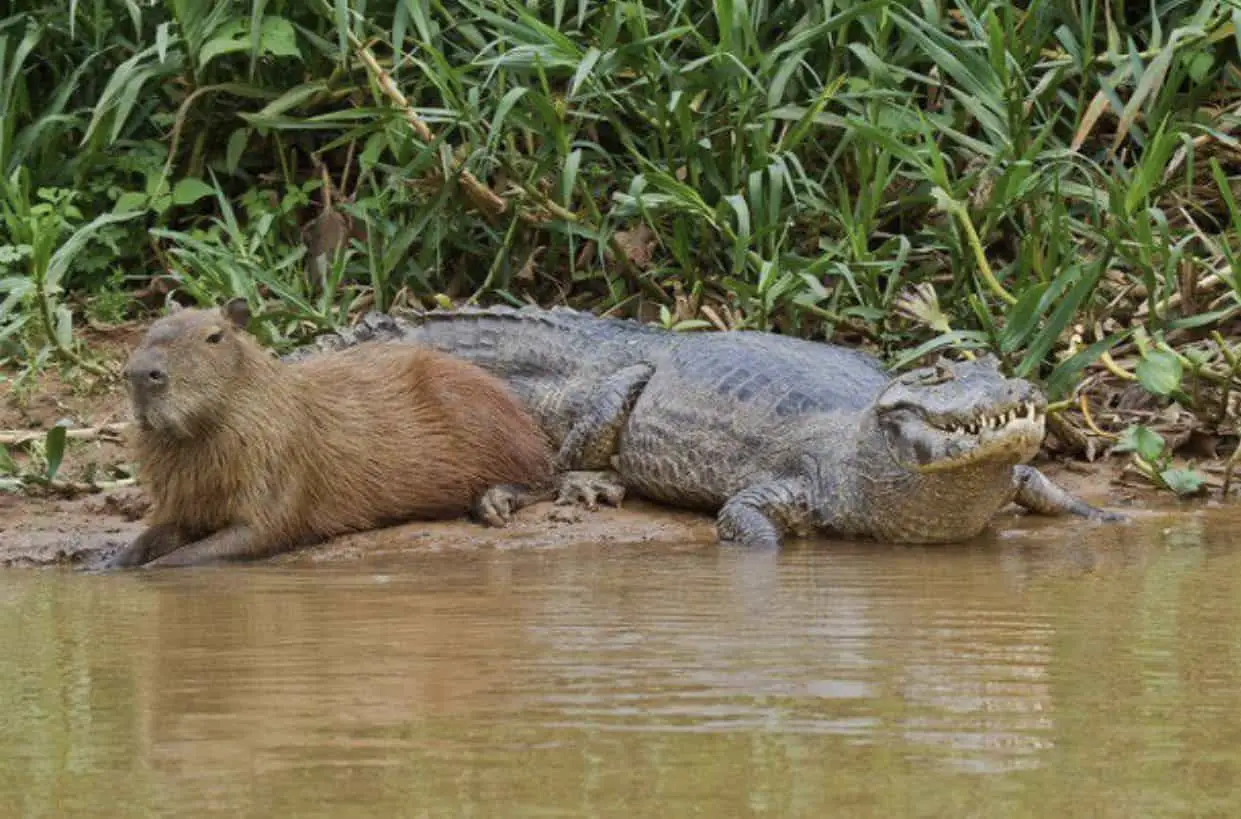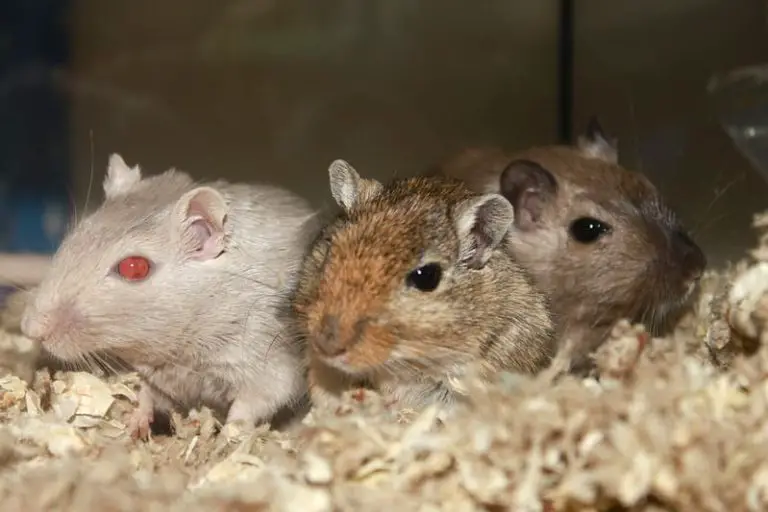Do Capybaras Have Any Predators?

The capybara is a very distinctive and unique rodent mammal. It is characteristic of South America, east of the Andes. Its environment is the Amazon forest and is related to rivers or lakes.
It is usually a bit more than one meter long and weighs approximately 35 to 65 kilograms. This herbivore is usually found in herds of up to 20 individuals and is generally considered to be a “good character” animal.
Due to its reputation as an affable, docile, and friendly animal that empathizes with other animals, there are many photos of the capybara on the web alongside other animals, one of these photos includes the capybara next to a crocodile, both in a gentle way, as if they got along well.
This is why the curiosity and the question of many arises, does the capybara have predators? and why doesn’t the crocodile eat the capybara?
The answer could be a little disappointing, the capybara, like all rodent animals, does have predators, including the alligator, although it has been possible to photograph an alligator next to a capybara in a quiet situation, this scenario is very unusual, since the alligator is one of the predators of the capybara, next to the jaguar.
The fact that there is a photo of a capybara next to a crocodile, does not mean that the alligator does not want or cannot eat the capybara, or that it is not a predator of this species, this has an explanation.
This photo was taken in a marshland, specifically in the Pantanal of Mato Grosso, a wetland located in Brazil, which was recognized as a biosphere reserve in 2000 by the United Nations Educational, Scientific, and Cultural Organization (UNESCO).
In the Transpantaneira Park in the Brazilian Pantanal. During the dry season, catfish are so easy to catch that the reptiles do not bother the herd of capybaras.
The catfish is a fish that can inhabit swamps and when there is a dry season it remains defenseless in the mud, the capybara instead when it feels danger it flees to the water, where it submerges or otherwise searches among the plants or reeds near the water.
Capybara Predators
These are some of the predators of the capybara, depending on the region where they are found:
- Caymans (alligators)
- Cougars
- Jaguars
- Anacondas
- Wild Dogs
- Vultures
- Ocelots
The Capybara and its difficult life surrounded by predators
Do you think that no animal attacks the capybara? the life of the capybara is not a rosy color, nor is it as shown in many of the photos that appear on the web, of the capybara surrounded by animals, calm and happy.
In reality, in nature the capybara has a hard life, surrounded by dangerous animals that can easily depredate it, the natural habitat of the capybara is in the basins of the Orinoco River as well as the Amazon or the Rio de la Plata, in these regions are concentrated most of them.
The Amazon is precisely known for having a large number of dangerous predators, one of these predators is the jaguar.
The jaguar is the largest phenyl that inhabits the American continent, and its skills as a hunter are unmatched, its bite is incredibly powerful, a capybara has no chance if a jaguar decides to hunt it.
Among the evasion tactics of the capybara to avoid its predators are to submerge in the water and swim, but unfortunately for the capybara, the jaguar is also capable of swimming (superficially) and hunting in the water.
Luckily for the capybara, the jaguar is a very rare animal to see, and its population is not widespread.
Another very dangerous and lethal predators that cohabit with the capybara in the waters of the Amazon are the anaconda, a huge constricting snake capable of killing and swallowing a whole capybara.
There is also the black crocodile, a reptile that can reach up to 6 meters in length and with exceptional hunting skills.
These are only some of the animals capable of easily depredating the capybara, without counting on others, to all this we must add that the capybara is also depredated by the dominant species of the planet, the humans.
How does the capybara defend itself from predators?
These rodents communicate with each other through vocalizations. When there is danger, they emit an alarm sound very similar to a dog’s bark.
The capybara can remain submerged for up to five minutes, without having to leave the surface to breathe.
Thanks to this ability, combined with their swimming skills, they often take advantage of the current of rivers and the depth of some lagoons to escape their predators.
What is the capybara’s main predator?
The capybara’s main natural enemies are the jaguar, ocelot, and canids, but at present, given the virtual disappearance of the big cats, the main predator is the man.
The human being is the biggest predator of the capybara
The main predator of the capybara is the Human, the locals used to hunt them as one of their main sources of food, since their meat is a great source of protein.
At the moment they have breeding grounds for the capybara, this is being done with 2 reasons, the first is for preserving the species and the second for feeding the people.
It is known that capybara meat is one of the traditional foods of the aboriginal South American Indians, not only in the part of territories of Colombia and Venezuela but also in Brazil and the Province of Buenos Aires, in the Republic of Argentina.
The fat of the body of the capybara is also used for supposed medicinal purposes and its leather is also used to manufacture different objects.
Capybara lifespan
The life expectancy of a capybara is fifteen years. They have jaguars, ocelots, snakes, alligators, and wild dogs as natural predators.
In some places, without a considerable number of predators, the population of capybaras can grow excessively, which can cause some problems for agriculture with the invasion of cultivated land.
In these places, control is done through hunting. Capybara meat is considered exotic meat and has great commercial value. They can also be hunted for the production of bags, wallets, clothing, and other leather goods.
Does the capybara get along with all the animals?
Capybaras are very sociable animals, they live in large groups composed of several dozen individuals who protect each other, and perhaps that is why other animals are comfortable with them, apart from their passive behavior.
The behavior of the capybara is passive and cooperative in relation to other species, as long as its territory is not invaded or threatened in nature, in captivity the capybara has been seen eating from the same dish with other species in a peaceful way
Is capybara at risk of extinction?
Capybaras are classified according to the Red List of Threatened Species of the International Union for the Conservation of Nature and Natural Resources (IUCN) in the category of “of little concern”. This means that this species presents little risk of extinction. However, this does not mean that capybaras are not threatened: they are the target of hunting for meat and leather.
It is quite difficult to see an endangered rodent as they reproduce very easily. The big problem of the capybara is human cruelty.
Because with so many specimens of this species being taken to the slaughterhouse or simply run over on the roads, many are also treated as pests and exterminated.
One of the biggest problems capybaras face is the destruction of their natural habitat, which forces them to migrate to urban regions.
Not being prepared to live in the urban environment, they end up being victims of trafficking and also of people who just want to get rid of these animals.
In some places where capybaras are disappearing, it is possible to observe the considerable increase of plants that previously did not exist in abundance because they served as food for these animals.






